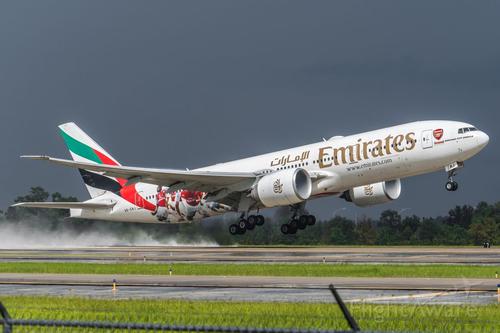Emirates Flight 419 Incident
Name
Institution
Emirates Flight 419 Incident
419 Incident代写 It was on Thursday 22nd Match 2007 when Emirates Boeing 777-300ER was on its international flight scheduled from Auckland to Sydney.
Short Description About the Incident
It was on Thursday 22nd Match 2007 when Emirates Boeing 777-300ER was on its international flight scheduled from Auckland to Sydney. The trip was under the call sign Emirates 419. There were 357 passengers on board, 16 cabin crews, and two pilots. The airplane was parked at the international terminal before take-off. The first officer had received instructions for the route clearance from the air traffic delivery controller. The pilots claimed to have listened to updated ATIS broadcast and previous ATIS in Sydney. The information from the two printouts did not differ, and hence, they choose to use updated ATIS for their take-off decision.
At the beginning of updated verbal ATIS broadcast were words saying “active runway mode normal operations…” The pilots were instructed that the active runway is 05 Right. Hidden from the pilot sight at the middle of the ATIS precautions “reduced runway length eastern end refer NOTAM B/1203”. Since it was a regular practice in flights, the first officer did not bother to ask the pilot on whether he has received ATIS Romeo. Even the controller assumed that the pilot has listened to the full command. Thus, the first officer failed to request for the extension of the runway 05R, which was set to the flight take-off.
The aerodrome apron controller instructed the first officer for take-off after he requested for push-back and start-up clearance. 419 Incident代写
Since it was not the apron obligation to ask whether the pilots have received relevant information, particularly ATIS, the officer went ahead and gave instructions. Although apron may have known the take-off runway was limited in length, it was not a requirement to ask the first pilot. Perhaps, the officer assumed it a routine procedure before issuing the clearance instructions.
Before the Emirates 419, the pilots had flown Emirates 418 from Sydney to Auckland. The pilots had the digital ATS printout and adviced by the captain that the standard procedure was to apply. The pilot listened to the command in updated ATIS before requesting for printout. Also, they had current flight printout, which instructed that the runway 05R was engaged. At the middle of it were words “reduced runway length eastern end refer NOTAM B/1203”.
On their pre-departure at Sydney, the pilots were prepared for limited landing at Auckland since they had with them NOTAM B/1203. However, at their pre-departure at Auckland, the runway was temporarily available as there was a departing long-haul flight from Auckland to Singapore. Sequentially, the Singapore long-haul was put bound at the runway to allow the landing of Emirates 418. Although Emirate 418 pilots knew the runway is limited, before their landing, the controller instructed them otherwise. Hence, they landed the Boeing 777 normally to the gate.
The first officer contacted the ground controller for instructions on Emirates 419 return flight to Sydney. 419 Incident代写
The ground controller instructed them 05R runway is available and but to hold at A10. The first officer repeated the instructions, and the controller signaled affirmative. The pilots were instructed to hold at A10. After a short while, Emirates 419 was cleared for runway 05R ready for take-off. The first officer was in control and had assumed reduced thrust take-off for full-length runway from A10.
Halfway the runway, the pilot realized that a vehicle obstruction ahead in the eastern end and abruptly applied take-off go-around (TOGA) thrust. According to the data, TOGA was used when the airplane had traveled 1327 meters, which were about 61 percent of the reduced length runway. The airspeed was 149 knots. The plane accelerated to plot’s predetermined take-off decision speed of 161 knots. The captain rotated the plane after acceleration to 163 knots before becoming airborne 190 m away from runway closed end.
The obs

tructions were from airport safety officers authorized to work on the runway. After the take-off, the plane wheels missed the vehicle with about 31 m. The climb rate of the aircraft was 2040 f/m, which raised to 5608 f/m. Later, the pilots reviewed ATIS and NOTAM for missed instructions. The case can be categorized as a controlled flight into terrain since the airplane was airworthy and under the control of pilots.
External Factors that Led to Threats 419 Incident代写
The crew encountered external threats which would have caused devastating results. At the runway were the runway safety team on a programmed work. With them was a vehicle on the closed eastern portion and a 3m rubber-removal truck. They were also faced by the threat of limited runway length which they approached with normal engine thrust and acceleration. Besides, the first officer was not sure whether the airplane would accelerate to the take-off speed before approaching the end of the available runway.
Another unforeseeable threat was the engine failure after immediate TOGA full thrust. The looming accident from the risks was fatal aircraft crash which would have resulted in casualties in both the passengers and safety team on the runway and a subsequent loss to the aviation company.
Internal Factors that Led to Threat 419 Incident代写
The threats were as a result of errors made by the crew. The pilots made information-processing errors which would have compromised the aircraft safety with its passengers, and ground personnel. Reason being they had the correct information as contained ATIS and NOTAM. Their prior knowledge about limited runway length on their landing from Sydney would have informed their assumption on the available runway length in Auckland airport on departure to Sydney at A10. The pilots were confused and perhaps led to their supposed assumption of no runway restrictions when on their landing Emirates 418, the updated ATIS indicated normal operations which were only available temporarily because of the outgoing long-haul bounded Singapore airplane.
Therefore, on landing Emirates 418 from Sydney, the pilots used a full-length runway. 419 Incident代写
The verbal ATIS at the start of the broadcast that changes the limited runway to full length made the pilots have fixed mindset that status on the restrictions have changed and hence full-length runway would be available on their turn-around flight to Sydney. The return flights to Sydney were routine. However, the available normal runway was reduced without them taking note. At the same time of ATIS broadcast update, though indicated regular operation, it had a provision of reduced length of runway 05R on the eastern end about NOTAM B/1203. The mindset from the ATIS broadcast update created a subconscious belief that the update on ATIS was a recall on runway restrictions.
The pilots’ mindset was further reinforced by the words “active runway mode normal operations…” The words were at the start of the updated verbal ATIS broadcast. Thus, it misled the pilots into assuming the existence of regular runway contrary to previous instructions. They ended up inadvertently overlooking the instructions at the middle of the ATIS that instructed on the reduced runway at the eastern end.
Therefore, although things seemed normal to ATS, the situation that faced the pilot was not normal. 419 Incident代写
The pilots needed to break from their mindset, but the ATS reinforced their decision by giving clearance for take-off. Nevertheless, the pilots failed to do diligent look at the standard procedures by listening to all and reading all ATIS information before the take-off. Hence, their action circumvented the defense mechanism against error. If they had thoroughly checked the ATIS, the error would have been avoided
Controls, Defenses, and Threat & Error Management Strategies 419 Incident代写
The incident was a lesson to the pilots and airport controllers. Therefore, it can be applied to devise controls, defenses, and threats and error management strategies. As a control measure, adequate precautions should be taken by all aerodrome controllers to ensure the crew has read and listened to all instructions and understood them. The pilots on the hand have the role in assuring they have diligently checked and followed all the necessary standards. Any repairs or schedules during regular traffic may contribute to errors and threats. Overall, the cross-checking mechanism should be applied for confirmation of various instructions and changes.

Controversies
The updated ATIS broadcast failed to appropriately serve the intended purpose of communicating crucial information to the pilots. Reason being, it was longer than recommended by ICAO, had permanent information, created contradiction by including words “normal operations” at the beginning and later gave a reference that advice “reduced runway length.”
Conclusion 419 Incident代写
Although the pilots managed the situation, it would have controlled from occurring and risking a fatal accident. Pilots have the responsibility to carefully check and request if any major changes have occurred as a standard procedure. The controllers also have the role of confirming and notifying the pilots of any unusual changes in the airport. The incident was, therefore, a collective oversight and hence, fault of both the controllers and pilots.
更多其他:艾莎代写 Review代写 研究论文代写 Case study代写 Essay代写 文学论文代写 Report代写 Admission Proposal代写 Academic代写




您必须登录才能发表评论。